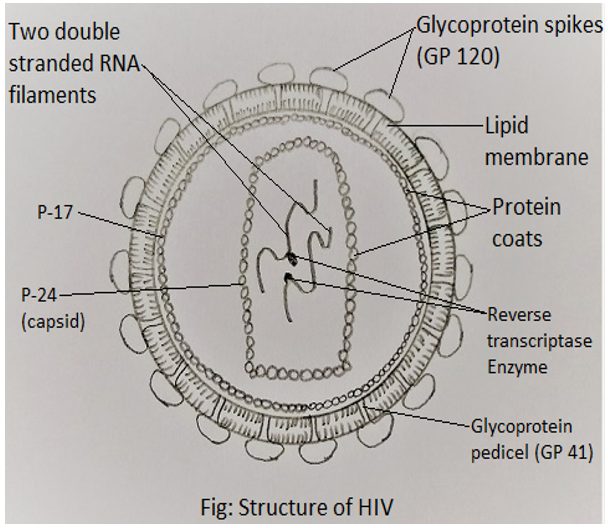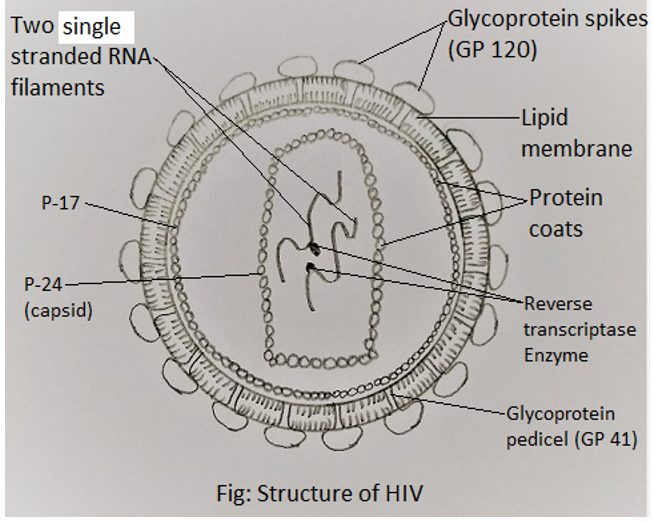This set of Class 12 Biology Chapter 8 Multiple Choice Questions & Answers (MCQs) focuses on “Human Disease – AIDS-2”.
1. How many HIV infected patients are believed to be present in India?
a) 1 million
b) 2.4 million
c) 3.8 million
d) 0.2 million
View Answer
Explanation: NACO through its 1200 nationwide sentinel surveillance sites believe that the number of HIV infected patients in India was 2.4 million at the end of 2009, out of the total 33 million present to be worldwide. 63% of the HIV infected individuals lived in Andhra Pradesh, Tamil Nadu, Karnataka and Maharashtra.
2. Group of people with a high risk of contracting HIV infection are children below 5 years of age.
a) True
b) False
View Answer
Explanation: Group of people with a high risk of contracting HIV infection include prostitutes, drug addicts, homosexual males, people with extramarital relations and recipients of unscreened blood transfusions.
3. Which of the following options is wrongly labelled in the diagram?

a) Two double-stranded RNA filaments
b) Glycoprotein pedicel
c) P-24 (capsid)
d) Lipid membrane
View Answer
Explanation: The viral envelope encloses the RNA genome which is single-stranded RNA filament, segmented into two identical filaments and associated with a reverse transcriptase enzyme. The correct labelled diagram is as follows:

4. Which of the following is not an opportunistic serious disease contracted in HIV infected patients?
a) Kaposi’s sarcoma
b) Toxoplasmosis
c) Leukoplakia
d) Influenza
View Answer
Explanation: Influenza may be contacted during an HIV infection but is not a serious opportunistic disease. Opportunistic serious diseases which can be contracted in HIV infected patients are Kaposi’s sarcoma, Toxoplasmosis, Leukoplakia, Herpes virus, Cytomegalovirus etc.
5. What is the normal count of Helper T-cells in human beings?
a) 1200/mm3
b) 800/mm3
c) 200/mm3
d) 2000/mm3
View Answer
Explanation: The normal count of Helper T-cells in human beings is 1200/mm3. If the count goes below 200/mm3 then HIV infection is suspected.
6. On which of the following cells, HIV virus attacks?
a) Red Blood Cells
b) Neuroglial cells
c) Platelets
d) Hair follicles
View Answer
Explanation: HIV virus attacks those cells which have CD4 receptor sites. It includes Helper T-cells, Macrophages, Neuroglial cells, Dendritic cells of the skin, etc.
7. Which of the following techniques is not used to diagnose HIV virus?
a) PCR
b) Western Blot
c) ELISA
d) Widal test
View Answer
Explanation: Widal test is used to diagnose typhoid. PCR is done in the window period when there are no antibodies against the virus. It is also the fastest test to diagnose HIV infection. ELISA and Western Blot are the antigen-antibody tests.
8. What is the full form of ARC?
a) Anaemia Related Complex
b) AIDS-Related Complex
c) Anxiety-Related Communication issues
d) Artificially Related Communicable diseases
View Answer
Explanation: ARC stands for AIDS-Related Complex. Fatigue, fever, repeated prolonged episodes of diarrhoea, night sweating, lymphadenopathy, splenomegaly and unexplained loss of weight are the common symptoms.
9. Which of the following drug is used for the treatment of AIDS?
a) Azidothymidine
b) Nevirapine
c) Acetaminophen
d) Alprazolam
View Answer
Explanation: Azidothymidine is a nucleoside analogue used for the treatment of AIDS. It prevents the function of Reverse transcriptase and hence slows down the replication of the HIV virus. However, death is inevitable.
10. HIV-I is more common in Africa and HIV-II is more common in India and USA.
a) True
b) False
View Answer
Explanation: HIV virus is of two types. HIV-I is more common in India, Europe and USA and HIV-II is more common in African regions. In India, the first AIDS was reported in 1986.
11. When is AIDS day celebrated?
a) 1st December
b) 1st November
c) 1st May
d) 1st August
View Answer
Explanation: AIDS day is celebrated on 1st December. AIDS was first reported in 1981 and in the last twenty-five years or so, it has spread all over the world killing more than 25 million people.
12. Full-form of HIV is _________
a) Human Infecting Virus
b) Haemorrhage Inducing Virus
c) Human Immunodeficiency Virus
d) Hay fever Inducing Virus
View Answer
Explanation: AIDS is caused by the Human Immunodeficiency Virus(HIV), a member of a group of viruses called retrovirus, which has an envelope enclosing the RNA genome.
13. AIDS virus belongs to which of the following group of viruses?
a) Reovirus
b) Retrovirus
c) Rhinovirus
d) Ribovirus
View Answer
Explanation: AIDS virus belongs to a group of viruses called Retrovirus which have an envelope consisting of a lipid bilayer derived from the host cell membrane and projecting knob like glycoprotein spikes with pedicel formed of virus called glycoprotein.
Sanfoundry Global Education & Learning Series – Biology – Class 12.
To practice all chapters and topics of class 12 Biology, here is complete set of 1000+ Multiple Choice Questions and Answers.
If you find a mistake in question / option / answer, kindly take a screenshot and email to [email protected]
- Check Class 12 - Biology Books
- Practice Class 12 - Physics MCQs
- Practice Class 12 - Chemistry MCQs
- Practice Class 11 - Biology MCQs
- Practice Class 12 - Mathematics MCQs
